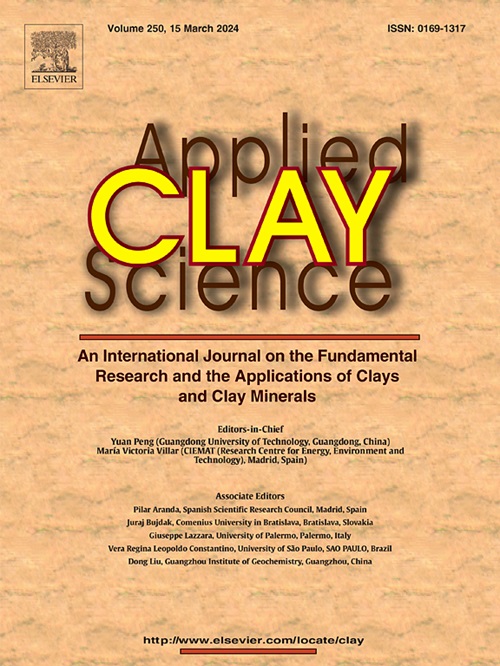Preparation of environmentally-benign, hydrophobic, phosphorus-/halogen-free, mono-component and hydromagnesite-based flame retardant for intensifying the fire safety of silicone rubber
IF 5.3
2区 地球科学
Q2 CHEMISTRY, PHYSICAL
引用次数: 0
Abstract
Aimed at settling the adverse effect of halogen−/phosphorus-containing flame retardants on the human health and ecological environment, a hydromagnesite (HM)-based flame retardant was prepared via sequential modification of polydopamine (PDA) and layered double hydroxide (LDH), which was expected to enhance the flame retardancy of silicone rubber (SR). The preparation feasibility for HM@PDA@LDH were confirmed by a series of characterizations in view of chemical composition, surface morphology, wettability and thermal degradation. The flame retardancy of 20 parts of HM@PDA@LDH per one hundred of silicone rubber (SR/20 phr HM@PDA@LDH) was upgraded with limiting oxygen index (LOI) of 30.5 %, Underwriters Laboratories-1894 Vertical burning-0 (UL-94 V-0) rating and peak heat release rate (PHRR) reduction of 59.6 % in comparison with neat SR. Besides, the possible mechanism was proposed by investigating the combustion residues of SR composites. Along with durable flame retardancy and maintained mechanical strength, the good balance among comprehensive properties of SR composites was gained. Thus, this paper proposed a valuable strategy for overcoming the contradiction between flame retardancy and environmental pollution, which was feasible for the real-world application of SR materials.
制备环境无害、疏水性、无磷/无卤素、单组分和氢氧化镁基阻燃剂,以提高硅橡胶的防火安全性
为了解决含卤/磷阻燃剂对人类健康和生态环境的不利影响,通过对多巴胺(PDA)和层状双氢氧化物(LDH)进行连续改性,制备了一种水镁石(HM)基阻燃剂,有望提高硅橡胶(SR)的阻燃性。从化学成分、表面形貌、润湿性和热降解等方面进行的一系列表征证实了 HM@PDA@LDH 制备的可行性。与纯硅橡胶相比,每 100 份硅橡胶中含有 20 份 HM@PDA@LDH (SR/20 phr HM@PDA@LDH)时的阻燃性能得到提升,极限氧指数(LOI)为 30.5%,达到美国保险商实验室-1894 垂直燃烧-0(UL-94 V-0)等级,峰值热释放率(PHRR)降低了 59.6%。此外,还通过研究 SR 复合材料的燃烧残留物提出了可能的机理。在持久阻燃和保持机械强度的同时,SR 复合材料还获得了良好的综合性能平衡。因此,本文为克服阻燃性与环境污染之间的矛盾提出了一种有价值的策略,这对于 SR 材料在现实世界中的应用是可行的。
本文章由计算机程序翻译,如有差异,请以英文原文为准。
求助全文
约1分钟内获得全文
求助全文
来源期刊

Applied Clay Science
地学-矿物学
CiteScore
10.30
自引率
10.70%
发文量
289
审稿时长
39 days
期刊介绍:
Applied Clay Science aims to be an international journal attracting high quality scientific papers on clays and clay minerals, including research papers, reviews, and technical notes. The journal covers typical subjects of Fundamental and Applied Clay Science such as:
• Synthesis and purification
• Structural, crystallographic and mineralogical properties of clays and clay minerals
• Thermal properties of clays and clay minerals
• Physico-chemical properties including i) surface and interface properties; ii) thermodynamic properties; iii) mechanical properties
• Interaction with water, with polar and apolar molecules
• Colloidal properties and rheology
• Adsorption, Intercalation, Ionic exchange
• Genesis and deposits of clay minerals
• Geology and geochemistry of clays
• Modification of clays and clay minerals properties by thermal and physical treatments
• Modification by chemical treatments with organic and inorganic molecules(organoclays, pillared clays)
• Modification by biological microorganisms. etc...
 求助内容:
求助内容: 应助结果提醒方式:
应助结果提醒方式:


